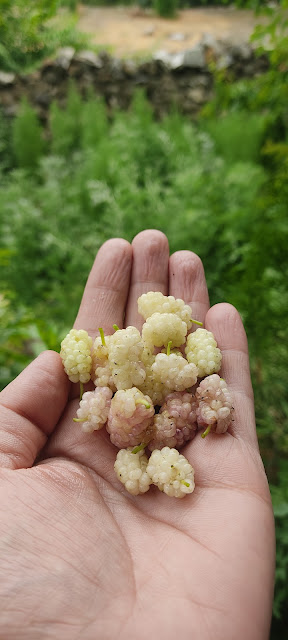SEA BUCKTHRONE
As a resident of Gilgit Baltistan you all are familiar with a
bead shaped orange colored fruits in your garden, probably you call it chanxshey
guno. Its scientific name is Hippophae and generally known as Sea Buckthrone.
If we go back to the history and usage of Sea Buckthrone we
find its connection with the ancient Greeks. It has been used by them as a
fodder of horses they used in the wars and races, remedy for many diseases
related to skin; it was a medicine of Eurasian continent and ancient Chinese
for skin injuries and sunburn.
Unaware of its benefits in the field of medicine and food sciences, Most of us try to get rid of it from our gardens as their throne seems difficult to handle while collection hay. The purpose of my writing is to provide an overview of the usage of this shrub as in Gilgit Baltistan we have plenty of Sea Buckthrone shrubs and almost every single person has an encounter with its throne at least once in life time while collecting hay, during shepherding or while walking in the beautiful meadows. Even I myself was oblivious of its benefits until I read a number of articles on web regarding it. Though we have lots of Sea Buckthrone in our garden I never dared to taste it before reading enough literature that insist me to taste it on my last year visit to Hunza. It was my first experience and I loved it and regretted for the ignorance.
Gilgit Baltistan has a
variety of undiscovered herbs and shrubs that can be used to improve the economic
condition of the region as well as can organize different researches in the field
of medicine and horticulture by collaborating with local and federal government
as well as by inviting renowned international NGO’s. Beside this the most
important thing that can lead our region towards development is choosing food
science and horticulture as a field of study for that we should encourage our
youth and initiate them towards realization and utilization of different resources
we are blessed with in Gilgit Baltistan.
On the global scale Sea Buckthrone is grown in different countries
the most common countries where it is found are; Pakistan, china, Denmark,
Netherlands, Germany, Poland, India, Nepal, Mongolia, Norway, Sweden, Russia,
France and in Britain. Chinese and Russians use it in different as a food. Beside
this it is use to extract juice and oil that are edible and are very healthy
for us. It contains the following nutrients and minerals;
1.
Vitamins (A, B2,
C,E, B1, P and K)
2.
Omega 7
4.
Magnesium
5.
Phosphorus
6.
Potassium
7.
Iron,
8.
Calcium
9.
Lead
10. Cadmium
11. Sugars
12. Organic Acids
13. Volatile compounds
14. Amino Acids
15. Sodium
16. Arytenoids
In many countries Sea Buckthrone
berries are used in different drinks as a flavor, to make juice that is very
good for our skin and a variety of dishes have been created using it some of
well known and favorite dishes around the world made with the orange colored
berries are mentioned below;
1. Fizzy Drinks
2. Soup
3. Different smoothies
4. Curd
5. different drinks
6. Jam
7. Pies
8. Jelly
9. As a flavor Mousse
10. As a flour in different kind of cakes
Sea Buckthrone has a
number of benefits for our health. Their seed, fruit, leaves and flowers are
used to treat different diseases. Since the ancient Greek era it has served as
a medicine to treat various diseases. Recent researchers found it useful to
fight against the following problems;
1.
Gastrointestinal
ulcers.
2.
Antimicrobial,
3.
Anti ulcerogenic
4.
Antioxidant
5.
Anticancer
6.
Radioprotective activity
7.
Platelet aggregation
8.
Liver injury
9.
Cardiovascular risk
factors
10. Effects on skin
and mucosa
11. Gout
12. Skin rashes caused by infectious diseases such as measles
13. Improving blood pressure
14. Lowering cholesterol
15. Preventing and controlling blood vessel diseases.
16. Boosting immunity
17. Improving sight
18. Slowing the aging process
19. Treating asthma
20. Treating heart conditions
21. Eczema
22. Dry eye
23. Protecting mucous membranes
24. Healing bed sores, burns and cuts
Along with all the
above benefits, there are chances of side effects because of limited research on
this shrub. It may cause problems by of using its leaves and extracts during
pregnancy and breast feeding, so women should avoid its usage to be on safe
side during this period. People with bleeding disorder must also avoid using it as it minimizes blood clots
that may result in increasing blood flow so people who scheduled a surgery must stop its consumption at least two
prior to the surgery to avoid high blood flow. It is also forbidden for people
with low blood pressure because it reduces blood pressure. We all should
consider the above cautions because still there is need of research on these shrubs.
Sources:
http://www.seabuckthorninsider.com
http://www.pjbs.org/pjnonline/fin185.pdf




Comments
Post a Comment